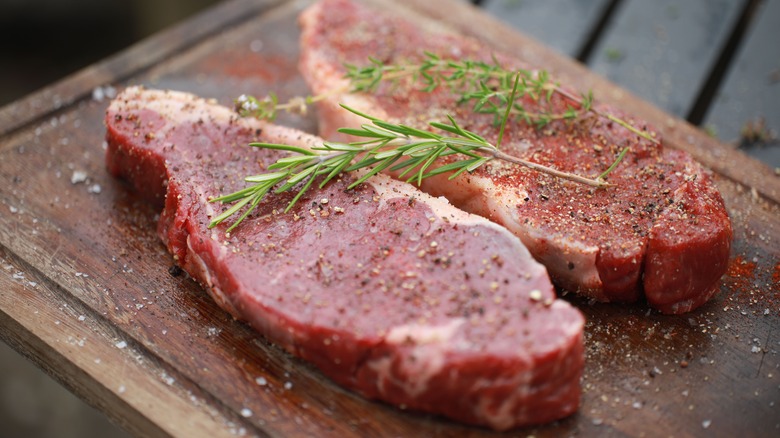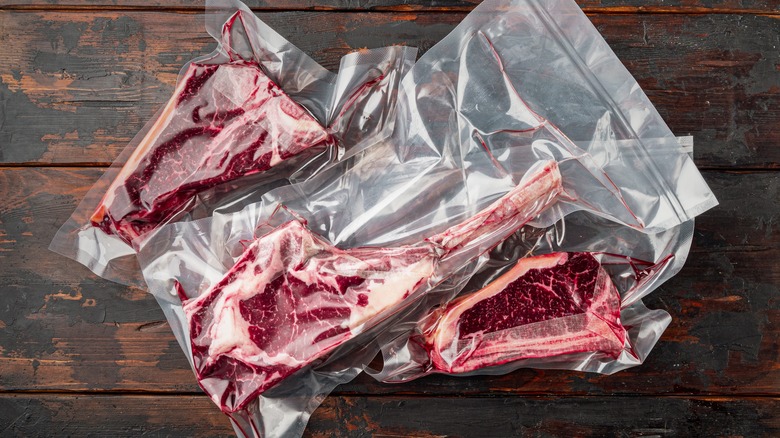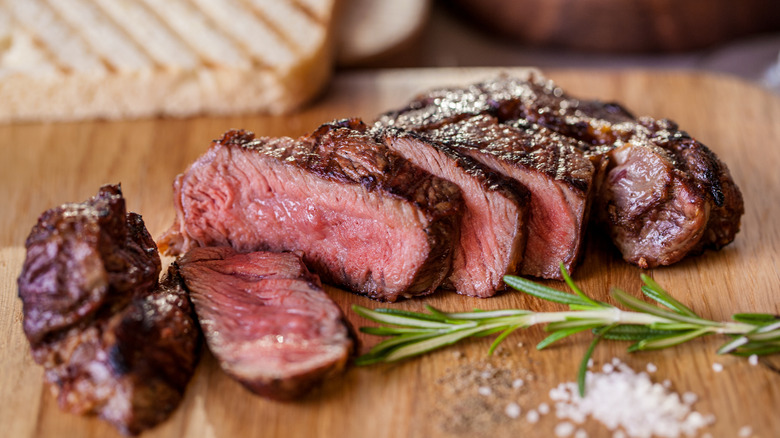What You Need To Know Before Adding A Spice Rub To Your Sous Vide Steak
Unless you've got dedicated time to stand next to a stovetop or grill, cooking the perfect steak can be tricky. It's easy to miscalculate and overcook, ruining an otherwise delicious piece of meat. But the sous vide method cuts out the guesswork — using a vacuum-sealed bag, a hot water bath, and a circulator, the technique can get a steak up to the correct temperature and keep it there for as long as you need, without any threat of overcooking. And since it's very much a set-it-and-forget-it kind of cooking method, the basics of sous vide are pretty easy to get a handle on once you have the equipment. But perfecting the flavor may require more experimentation.
Your typical steak seasoning techniques may not work in the vacuum-sealed bag the same way they do on the grill. Even if you generously season the steak with a spice rub before putting it in the bag to cook, it's likely that the steak will emerge with a different flavor intensity than you'd hoped. To ensure concentrated spice flavor, it's better to add the rub to the steak after the sous vide cooking process.
For more predictable flavor, rub your spices post-sous vide
Cooking steak with a nicely browned crust relies on the Maillard reaction, a process that every home cook should understand. Scientifically, the Maillard reaction is a heat-prompted chemical reaction between amino acids and reducing sugars — practically, it's what gives browned food its distinctive nutty, toasty taste. But that doesn't happen with the sous vide method. There's no searing happening in the vacuum-sealed bag, and the perfectly cooked steak that emerges still needs a finishing sear to lock in flavor and juices. Many sous vide recipes call for generous aromatics (like herbs) in the bag to infuse the steak with the flavor that it would otherwise miss, but with spice rubs it's better to add after the steak comes out of the bag.
The heat of searing or grilling removes moisture and adheres spices and marinades to the steak as it creates that browned crust. But since sous vide traps the moisture and the juices in the bag with the steak, experts have found that spice rubs will typically just slide off instead of being locked in (and the juices will be flavored, instead of the steak). Although many chefs still swear by aromatics, herbs and garlic in the bag might not have a huge impact. The temperature of sous vide isn't high enough to denature the botanicals, and the steak's system of proteins is intricate enough that it's difficult for any seasoning other than salt to sink in or stick.
How to fix the flavor of your steak
You may be thinking, "Well, what's the point of sous vide, if my steak will be bland?" But there are definitely ways around the flavor issue so that you can take advantage of the even-cooking, hands-off benefits of sous vide while still enjoying a dish that tastes delicious. Once the steak has already finished cooking in the bath, pat it dry, then rub it generously with your spice blend of choice. Then let the meat sizzle in the pan or on the grill just enough to get that signature crust. It won't take long, and the flavor of spices will be fixed to the steak.
If you don't want to sear as well as sous vide, you can also add some powdered egg white to your spice rub recipe. Egg whites contain a sticky protein called albumen, which will help the spices stay on the meat after it's been cooked. Take the finished steak out of the sous vide bag, then pat it dry. Sprinkle some powdered egg white on top and spray just a little bit of water, then add your spices or chopped herbs on top. No missing flavor here, just the perfect sous vide steak.


